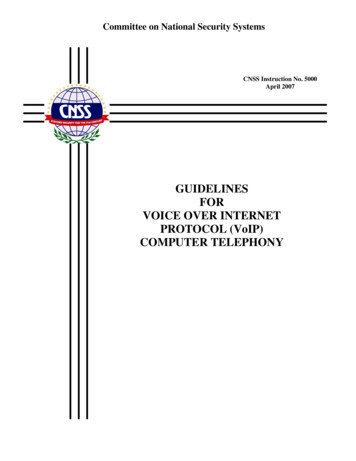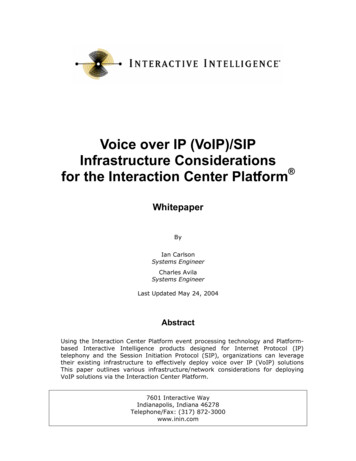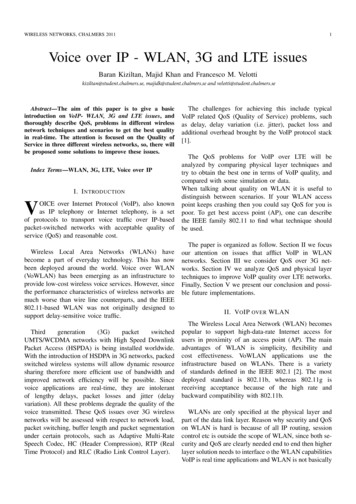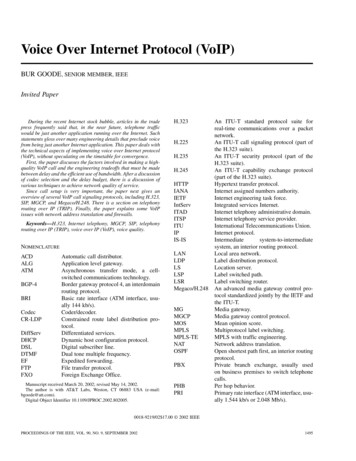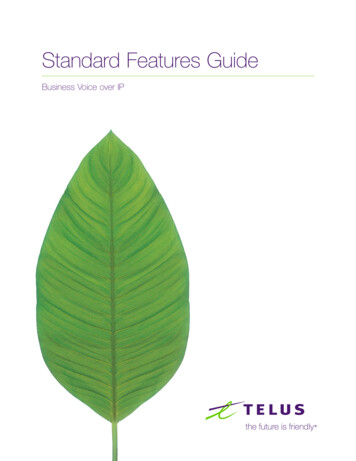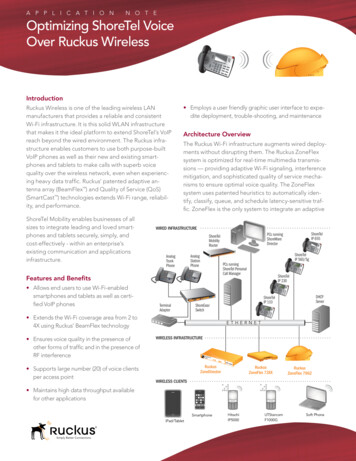
Transcription
Mark H. Goldberg& Associates Inc.www.mhgoldberg.comRegulating Voice over IP:A solution for the CRTCMarch, 2005Executive SummaryVoice over Internet Protocol (VoIP) is a capability that has moved into themainstream. Telecom regulators around the world are being challenged to issuepolicy determinations to govern the industry as incumbent telephone companiesand new competitors introduce competitive services based on VoIP technology.The Canadian Radio-television and Telecommunications Commission (CRTC) hasissued a preliminary determination that views VoIP as just another technologyupgrade to deliver conventional local phone service. As such, the CRTC hasinitially proposed that VoIP would be regulated in the same way that regularphone service is regulated: full regulation for the phone companies; lightregulation for new competitors.We disagree. In our view all VoIP service providers should be treated equally,with regulation limited to public safety, social and consumer protection issues.Contrary to its initial views, the CRTC should not extend price regulation on toinclude VoIP services.We have 3 reasons for our view: First, VoIP service dissociates the voiceapplication from the physical infrastructure (i.e. the line). VoIP transforms voiceMarch 4, 2005i
Mark H. Goldberg& Associates Inc.Regulating VoiceOver IPwww.mhgoldberg.comPage iiinto a customer premises based software application. The CRTC has rightlymoved away from regulating such applications in the past, including theapplicability of Contribution payments, and it does not have any reason to actdifferently in this case. The fact that such an application can be used as asubstitute for a regulated service like voice, does not mean that economicregulation for VoIP is warranted.Second, we suggest that the regulator needs to return to first principles, and askthe question of “why regulate?” In telecom, regulation has been required wherefacilities (the hardware and software infrastructure) created a bottleneck. If asingle provider had market power through its control of the bottleneck facility,regulation was required to discipline that market power. Conventional voiceservice has been sold as an inseparable bundle of a voice application andnetwork access. The network access portion was historically a bottleneck facilitythat required regulation. By contrast, VoIP services on the market today are onlysoftware applications. In examining the issue of whether to regulate, the CRTChas to determine whether anyone has market power in respect of the voiceapplication. Given the number of new entrants in VoIP, it is unlikely that anyonecould be found to have such market power. The confusion in this debate ariseswhen network access is bundled along with VoIP. In those situations, oursuggestion to the CRTC is that their current bundling rules are sufficient to dealwith the issue. If a VoIP service is bundled with network access and that accessis subject to market power, regulation should be used to keep the power incheck. However, if the bundled network access is competitive, such as the CRTChas found in the case of high speed internet access, no economic regulation isrequired for the providers of VoIP services.March 4, 2005ii
Mark H. Goldberg& Associates Inc.Regulating VoiceOver IPwww.mhgoldberg.comPage iiiFinally, the CRTC has a useful precedent to draw upon in deciding the issue ofVoIP regulation. Like VoIP, mobile wireless services share many of the samecharacteristics of conventional voice service. Yet, when wireless services werefirst introduced, the CRTC found that Canadians would obtain the greatestbenefits if wireless services were governed, as much as possible, by marketforces rather than by regulation. Such thinking has contributed to the success ofcompetition in wireless services in Canada. The CRTC now has an opportunity toobtain similar success in VoIP.We believe that all VoIP service providers that make use of Canadian numbersshould be regulated in respect of providing access to emergency services andmaintaining responsible levels of consumer privacy. However, regulation shouldbe limited to the most fundamental consumer safeguards and ensuring that allmarket participants have fair and equitable access to bottleneck facilities. Assuch, as long as the voice application is unbundled from the access facilities,there is no need to regulate the price of VoIP service. Conversely, if theapplication is bundled with an access service that is not competitive, theCommission’s existing bundling rules will come into effect.Wireless services and VoIP are the leading trends in telecommunications aroundthe world. The CRTC had it right when it found that “the benefits which usersmay derive from this innovative service are likely to be greater if the terms of itsprovision are governed, as much as possible, by market forces rather than byregulation.” It used these words more than 20 years ago in respect of wirelessservices. It should reach the same conclusions today in respect of VoIP.March 4, 2005iii
Mark H. Goldberg& Associates Inc.Regulating VoiceOver IPwww.mhgoldberg.comPage ivTable of ContentsExecutive Summary. iTable of Contents .ivIntroduction . 1Why regulate? . 2Regulating VoIP On The Basis Of Functional Equivalence . 3Evidence of Competition or Market Power. 6VoIP as an Application . 7The CRTC Proceeding on VoIP. 9Regulation of VoIP . 9The Regulation of Conventional Voice Technologies. 10The Regulation of Wireless Services. 14Developing VoIP Regulation. 17Consumer Safeguards. 18Emergency Services . 19Message Relay Service . 20Contribution. 21Summary. 25Credentials:. 27March 4, 2005iv
Mark H. Goldberg& Associates Inc.Regulating VoiceOver IPwww.mhgoldberg.comPage 1IntroductionRegulators regulate. It is just what they do. It is in their job descriptions toregulate. In fact, the Telecom Act requires the CRTC to begin with thepresumption that it has to regulate, until it is provided with proof that it does notneed to regulate. 1In other areas of technology, entrepreneurs compete against larger companiesand sometimes win and sometimes lose depending on what the marketplacedecides. Larger players are often slow to respond to competitive threats, but arefree to do so, subject to commercial business and competition laws. Not so fortelecommunications services. Like most countries around the world, in Canadatelecommunications services are regulated by a specialist body, the CRTC – theCanadian Radio-television and Telecommunications Commission. However, unlikethe regulators in many of Canada’s most important trading partners, the CRTCcontinues to approach new technologies and services with a presumption that itmust regulate them.2 It isn’t surprising. It’s just what the legislation encouragesthe regulator to do.This paper will argue that Internet telephony does not need to be subjected toretail price regulation; that market forces are the best mechanism for maximizing1Telecommunications Act, S.C. 1993, c.38, Section 34 provides relief from regulating only aftermaking a determination as a question of fact that it does not need to regulate. Such adetermination allows the CRTC to refrain from regulating under Sections 24, 25, 27, 29 and 31 –which limit the abilities of carriers to offer services without prior approval of the Commission.2By contrast, the New Regulatory Framework for Electronic Communications for the EuropeanUnion reverses the presumption for regulation. The EU requires its member states “to promotecompetition in the provision of electronic communications networks, electronic communicationsservices and associated facilities and services” (Framework Directive, 2002/21/EC, OJ L 108,24.4.2002, Article 8.2). In Canada, fostering an “increased reliance on market forces” is but oneof eight competing objectives cited in Section 7 of the Telecom Act, with no particularprecedence given to one over the others.March 4, 20051
Mark H. Goldberg& Associates Inc.Regulating VoiceOver IPwww.mhgoldberg.comPage 2consumer benefits such as increased choice, encouraging innovation and lowerprices; and, that forbearance from rate regulation of VoIP is consistent with theapproach followed by the CRTC in other areas of new technology, such as mobilewireless services. The paper will review the issues that were examined duringthe CRTC’s Voice over Internet Protocol (VoIP) public proceeding and propose alight-handed and efficient regulatory treatment that allows consumers to benefitfrom increased innovation, based on competitive market forces. The role of theregulator in VoIP should be limited to ensuring certain consumer safeguards aremaintained and enforcement of equitable access to bottleneck facilities by allmarket participants.Why regulate?Contrary to the views of many observers that the Internet can not be regulated,the CRTC indeed has the power to regulate VoIP. It certainly has the ability tolimit the involvement of Canada’s largest phone companies in this sector, if itchooses to regulate VoIP in the same manner that it deals with conventionaltelephone service. But, the proper question isn’t “can they regulate?” It is: “whywould the CRTC want to regulate?”The CRTC is required to regulate with a view to the implementation of eightsometimes competing Canadian telecom policy objectives.3 It has typicallyregulated by trying to balance the interests of consumers, incumbent carriersand competitors. One of the policy objectives set out in the Telecom Act is ‘tofoster increased reliance on market forces,’ which has led the CRTC to forbear orrefrain from regulation in a number of markets. The Act requires that the CRTCrefrain from regulating a service where the CRTC determines that there will be3Telecommunications Act, S.C. 1993, c.38, Section 7.March 4, 20052
Mark H. Goldberg& Associates Inc.Regulating VoiceOver IPwww.mhgoldberg.comPage 3sufficient competition to protect the interests of users. 4 The Commission’s criteriafor making such a determination have been that significant barriers to entry havebeen removed and that workable competition either exists or will occur withinthe next two years. 5Regulating VoIP On The Basis Of Functional EquivalenceIn response to industry requests to examine the regulatory issues surroundingVoIP, the CRTC began a public notice process to figure out how to deal with thismajor disruptive force on the telephone service – a technology that promises toturn the entire industry on its head.6 Sometime in early 2005 we will hear whatthe CRTC decides.Partly recognizing that technologies were moving faster than the CRTC could, theCommission took the unusual step of stating its preliminary views on VoIP, as anindicator of what key issues upon which people should comment. The CRTC’sview was that on the basis of functional equivalence and technological neutrality,VoIP should be subject to the same regime as conventional voice service.VoIP services utilize telephone numbers that conform to the NANPand allow subscribers to call and/or receive calls from anytelephone with access to the PSTN anywhere in the world. In theCommission's preliminary view, these characteristics of VoIP4Telecommunications Act, S.C. 1993, c.38, Section 34 (2).5Review of Regulatory Framework, Telecom Decision CRTC 94-19, p.696As noted in Regulatory framework for voice communication services using Internet Protocol,Telecom Public Notice CRTC 2004-2 (‘PN 2004-2’), at paragraph 6: “On 6 November 2003, BellCanada submitted an application requesting, among other things, that the Commissioncommence a proceeding to address the rules, if any, which govern the provision oftelecommunications services by cable companies and other service providers that offer VoIPservices. On 12 January 2004, Call-Net Enterprises Inc. submitted a letter asking what regulatoryrequirements would apply to service providers that are now offering VoIP services.”March 4, 20053
Mark H. Goldberg& Associates Inc.Regulating VoiceOver IPwww.mhgoldberg.comPage 4services are functionally the same as those of circuit-switched voicetelecommunications services.Consistent with the principle of technological neutrality, in theCommission's preliminary view VoIP services should be subject tothe existing regulatory framework, including the Commission'sforbearance determinations.7Not surprisingly, the Canadian Cable Telecommunications Association (CCTA),among many others, agreed with the CRTC’s preliminary view. The CCTA saidthat VoIP is a ‘close substitute for existing primary exchange services.’8 ‘VoIPservices are used to provide local exchange service, as well as long distanceservice and calling features, just as circuit-switched voice services are today.’9While th
Regulating Voice over IP: A solution for the CRTC March, 2005 Executive Summary Voice over Internet Protocol (VoIP) is a capability that has moved into the mainstream. Telecom regulators around the world are being challenged to issue policy determinations to govern the industry as incumbent telephone companies




